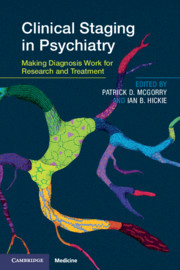Book contents
- Clinical Staging in Psychiatry
- Clinical Staging in Psychiatry
- Copyright page
- Contents
- Contributors
- Foreword
- Acknowledgements
- Section 1 Conceptual and Strategic Issues
- Section 2 Progress with Clinical Staging
- Section 3 Novel Treatment Strategies
- Chapter 11 Novel Biological Treatment Strategies
- Chapter 12 Psychosocial Interventions for Youth Mental Health
- Section 4 Novel Treatment Strategies
- Index
- Plate Section (PDF Only)
- References
Chapter 12 - Psychosocial Interventions for Youth Mental Health
from Section 3 - Novel Treatment Strategies
Published online by Cambridge University Press: 08 August 2019
- Clinical Staging in Psychiatry
- Clinical Staging in Psychiatry
- Copyright page
- Contents
- Contributors
- Foreword
- Acknowledgements
- Section 1 Conceptual and Strategic Issues
- Section 2 Progress with Clinical Staging
- Section 3 Novel Treatment Strategies
- Chapter 11 Novel Biological Treatment Strategies
- Chapter 12 Psychosocial Interventions for Youth Mental Health
- Section 4 Novel Treatment Strategies
- Index
- Plate Section (PDF Only)
- References
Summary
Traditionally a focus on functional recovery in mental illness was seen as something that happened, if at all, after symptoms had been dealt with. In the context of staging, this would be in the later stages of more established illness. Recent research has shown that a focus on functional recovery goals is a necessary part of early stage interventions (stages 1 and 2) both as a means to the prevention of disability and for long term functional recovery. In practice, this means that young people with mental illness need attention not only to their mental health symptoms, but also to the areas of functioning that restrict their capacity to live a fulfilled life in the community from their earliest contacts with mental health services. This is because despite improvements in medications and psychological therapies, people with mental illness still have poor outcomes in functional domains such as vocation, physical health, housing, and incarceration. This chapter reviews two of these areas: vocational functioning and physical health. It examines the extent of these issues, provides guidance on evidence-based interventions, and highlights evidence gaps, and considers new modes of intervention based on better utilisation of existing and emerging technologies. For clinicians working with young people with mental ill health, it is imperative to address functional recovery as part of the core treatment of early stage illness. To this end the chapter also details the clinical and research lessons in each of these areas.
- Type
- Chapter
- Information
- Clinical Staging in PsychiatryMaking Diagnosis Work for Research and Treatment, pp. 241 - 260Publisher: Cambridge University PressPrint publication year: 2019
References
- 2
- Cited by



